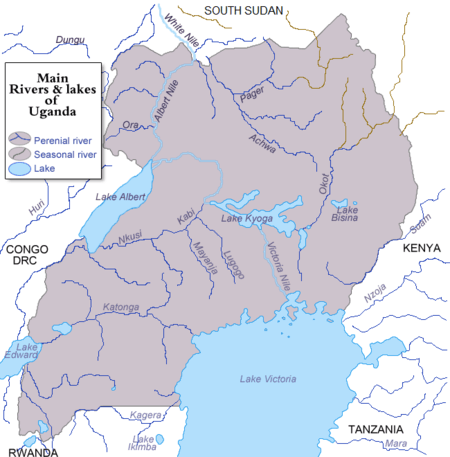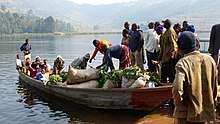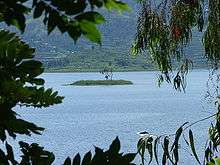Lake Bunyonyi
Lake Bunyonyi ("Place of many little birds") is in south-western Uganda between Kisoro and Kabale,[6] and it is close to the border with Rwanda. The lake appeared from 2004 to 2009 on the 5,000 Ugandan shilling note under the title "Lake Bunyonyi and terraces".[7] Scientific literature generally quote a maximum depth of 40 m (130 ft),[2][3][4][5] but some tourist guides and locals insist that it much deeper, about 900 m (3,000 ft), which would make it the second-deepest lake in Africa.[8][9][10]
| Lake Bunyonyi | |
|---|---|
.jpg) | |
| Location | South-western Uganda |
| Coordinates | 1°17′S 29°55′E |
| Type | fresh water |
| Basin countries | Uganda |
| Max. length | 25 km (16 mi) |
| Max. width | 7 km (4.3 mi) |
| Surface area | 46 km2 (18 sq mi)[1] |
| Average depth | 39 m (128 ft)[1] |
| Max. depth | 40 m (130 ft)[2][3][4][5] (sometimes claimed to be much deeper, see text) |
| Shore length1 | 186 km (116 mi)[1] |
| Surface elevation | 1,962 m (6,437 ft) |
| 1 Shore length is not a well-defined measure. | |

Towns on its shores include Kyevu and Muko, while its 29 islands include Punishment Island and Bushara Island.
Geography

Lake Bunyonyi is a body of water 7 kilometres (4.3 mi) west of Kabale town.[11]
Main islands
Akampene (Punishment Island)

The Bakiga used to leave unmarried pregnant girls on this small island with - to die of hunger or while trying to swim to the mainland (swimming skills were rare).[12] This was to intimidate the rest, to show them not to do the same. A man without cows to pay the bride price could go to the island and pick up a girl.[12] The practice got abandoned in the first half of the 20th century.[12]
.jpg)
Bwama and Njuyeera (Sharp's Island)
In 1921, English missionary Leonard Sharp came to this part of Uganda and in 1931 established a leprosy treatment centre on the then uninhabited Bwama island.[13] A church, patient quarters (model villages), and a medical facility were built, while Sharp settled on Njuyeera Island (probably meaning "white cottage" after the similarity of the doctor's small white house to Sharp's father's house in Shanklin, now The White House Hotel). The rationale of the leprosy colony was that of "voluntary segregation'", where the provision of a happy community to live in would attract leprosy sufferers, so removing them from the communities where they might infect others.[14]
Ecology
Except for water birds, few aquatic animal species are naturally present in this isolated highland lake, which is near but not quite connected to the greater Nile basin. Its water is highly stratified with the oxygen limit placed at a depth of about 7 m (23 ft).[2]
Native vertebrates include the De Witte's clawed frog, Lake Victoria clawed frog ("bunyoniensis" form), African clawless otter and spotted-necked otter, but only the first frog is still common in the lake.[2] Four endemic species of Caridina shrimp are found in the lake;[15] there are indications that they might also occur in Lake Mutanda.[2] Originally, there were no fish or crayfish in the lake, but the catfish Clarias liocephalus, Nile tilapia, Singida tilapia, haplochromine ciclids of Lake Victoria origin and red swamp crayfish have been introduced.[2]
Aquatic vegetation is locally abundant and include species such as papyrus, swamp sawgrass (subspecies jamaicense) and blue lotus.[2]
Tourism
Lake Bunyonyi is popular for its green and lush terraced hills that are punctuated with a plethora of over 200 bird species. The place combines the art of water birds and some migratory birds. This makes it a perfect ideal for many bird enthusiasts. A dive into the Nyombi swamp reveals a variety of assorted birds. Apart from birdwatching, the place also present perfect. These include sports like swimming as well as boat cruising and riding. The area is also underlined by various hikes and nature walks, all of which offer more than just nature and pleasure. A sense of traditional culture is also felt during the community walks, since one can get stop overs at the Bakiga Cultural museum as well as the blacksmith sites. For more cultural adventures, one can visit the village of Bufuka for Batwa and Bakiga experiences.
References
- UNEMA 2009, p. 94.
- Green, J. (2009). "Nilotic Lakes of the Western Rift". In H.J. Dumont (ed.). The Nile. Monographiae Biologicae. 89. Springer Science + Business Media B.V. pp. 263–286. ISBN 978-1-4020-9725-6.
- Denny, P. (1972). "The significance of a pygnocline in tropical lakes". The African Journal of Tropical Hydrobiology and Fisheries. 2 (2): 85–89.
- Tibihika, P.D.M.; W. Okello; A. Barekye; D. Mbabazi; J. Omony; V. Kiggundu (2016). "Status of Kigezi minor Lakes: A limnological survey in the Lakes of Kisoro, Kabale and Rukungiri Districts". International Journal of Water Resources. 8 (5): 60–73.
- Visser 1962, p. 81.
- DENNY, PATRICK (April 1973). "Lakes of south-western Uganda". Freshwater Biology. 3 (2): 123–135. doi:10.1111/j.1365-2427.1973.tb00067.x. ISSN 0046-5070.
- "5.000 Shillings banknote of Uganda". banknote.ws. Retrieved 2019-09-13.
- "Lake Bunyonyi Islands Guide, Where To Stay, Getting There, Activities Attractions". Lake Bunyonyi. Retrieved 2019-05-09.
- "LAKE BUNYONYI UGANDA". Lake Bunyonyi Uganda. Retrieved 2019-05-09.
- "Africa's second deepest lake, Bunyonyi decreases by two metres". Daily Monitor. Retrieved 2019-05-09.
- Maclean, Ilya. (2003). Social and economic use of wetland resources : a case study from Lake Bunyonyi, Uganda. Centre for Social and Economic Research on the Global Environment. OCLC 1064481271.
- "Uganda's Punishment Island: 'I was left to die on an island for getting pregnant'". BBC. 24 April 2017. Retrieved 24 April 2017.
- Not a gap year but a lifetime. Katherine Makower. 2008. Apologia Publications, Eastbourne, UK.
- Island of miracles. Leonard Sharp. 2nd Ed. Battley Brothers Limited, Queensgate Press, Clapham Park, SW4
- Richard, J.; P.F. Clark (2005). "Caridina nilotica (P. Roux, 1833) (Crustacea: Decapoda: Caridea: Atyidae) from East Africa, with descriptions of four new species". Proceedings of the Biological Society of Washington. 118: 706–730. doi:10.2988/0006-324X(2005)118[706:CNPRCD]2.0.CO;2.
Sources
- UNEMA (2009), Uganda: Atlas of our Changing Environment (PDF), Uganda National Environment Management Authority, p. 94
- Visser, S.A. (1962), "Chemical Investigations into a System of Lakes, Rivers and Swamps in S.W. Kigezi, Uganda", East African Agricultural and Forestry Journal, 28 (2): 81–86, doi:10.1080/00128325.1962.11661848
External links
| Wikimedia Commons has media related to Lake Bunyonyi. |
- https://www.youtube.com/watch?v=459-IrnCR5Y - a beautiful video about lake Bunyonyi
- http://www.bunyonyi.org - A guide To Lake Bunyonyi